Core i3-2120 and Core i3-2100 Processors Review

Sandy Bridge is not only high-performance quad-core CPUs. There are also inexpensive dual-core LGA1155 processors in this family, and today we are going to talk about them in our new article.
We have already dedicated quite a few articles to the new Intel Sandy Bridge processors. We have gone into the tiniest details of their microarchitecture, tested the most popular Core i5-2500, Core i5-2400 and Core i5-2300 CPU models, discussed a Core i5-2400S processor with lower power consumption, checked out the overclocker-friendly Core i5-2500K and Core i7-2600K, and admired impressive energy-efficiency of the 35 W Core i3-2100T. It appears that out of all second generation Core processors currently available in retail we haven’t yet given personal treatment only to two Core i3 CPUs. Time has come to correct this omission, so today we are going to talk about Core i3-2120 and Core i3-2100 processors.
Core i3 processors from the Sandy Bridge family have two distinguishing features. First, it is their low price. At this point and until Intel rolls out Pentium processors based on the new microarchitecture, these would be the junior LGA1155 processors. They set the minimal price for entering the Sandy Bridge club at $120-$140.
The second distinguishing feature between Core i3 and the higher-end models is the dual-core design. Although the second-generation Core solutions are manufactured using the latest 32 nm process, the introduction of four computational cores into inexpensive processors would be a waste for Intel. It is AMD, who have to resort to a measure like that, because right now they do not have any other way of making their inexpensive processors fast enough. As for Intel, they have no problems with the performance of their individual processor cores, so CPUs with two computational cores inside is a pretty normal occurrence for contemporary mainstream and entry-level systems. Especially, since they also have the remarkable Hyper-Threading technology at their disposal, which allows each of the cores to execute two threads at the same time. And by the way, dual-core design is used successfully not only in the Core i3 series discussed today. Similar Sandy Bridge processors are popular in mobile computer systems, even in the mainstream segment, where they are called Core i5 and even Core i7.
However, in desktops dual-core design won’t go in anything more expensive than Core i3. Although in the near future Intel is going to introduce dual-core LGA1155 Pentium and Celeron processor families, which will also be based on Sandy Bridge microarchitecture. In other words, dual-core processors in Intel’s representation are far from ending their life span and should live happily for a considerably while longer.
Speaking of the desktop processors, we would like to stress that when they rolled out new microarchitecture, the nomenclature of their base LGA1155 processor lineup started to make even more sense:
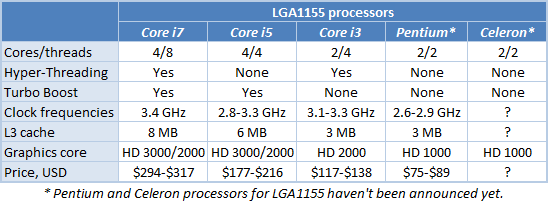
No matter what they say about the sufficient performance of the new generation dual-core CPUs, we still notice that there is no dual-core design in the Core i5 series any more. Should we take it as a hint that dual-core processors get close to becoming morally obsolete and we should get used to the idea that a contemporary computer system must have a quad- or even six-core CPU inside? Or is it a mere attempt to completely destroy the competition in the mainstream price segment? Let’s try and figure this out now.
Closer Look at Core i3-2120 and Core i3-2100
We collected all the key information about junior Sandy Bridge processors in a separate chapter of our review, because it turned out to be really overwhelming. But most importantly, the dual-core Sandy Bridge uses its own semiconductor die, different from those used in Core i5 or Core i7. As a result, Intel managed to lower the price of their Core i3 CPUs quite substantially, which you can clearly see from the following table:
The die used in the new Core i3 is 40% smaller than the semiconductor die in the fully-functional quad-core Sandy Bridge processors. This allows Intel to use these dies for very inexpensive processors, which so far are only available in Core i3 series, but later should also emerge as Pentium and Celeron processors with even more democratic price.
However, the use of a special semiconductor die for Core i3 processors also has a different side to it. Namely, it eliminates all hopes for possibly unlocking the new cores, like can be done with AMD CPUs. Unfortunately, this is not the only thing that may discourage computer enthusiasts from going with Core i3 family. Overclocking also revealed several problems.
LGA1155 Core i5 and Core i7 processors, even those that do not belong to the overclocking-friendly K-series, do allow some limited overclocking anyway. These CPU allow increasing their clock frequency multipliers by a four points above the nominal. At the same time they keep Turbo Boost technology up and running and it additionally increases the multiplier in automatic mode depending on the current load. Core i3 processors do not support Turbo Boost as well as increasing the multiplier above the nominal value. And keeping in mind that LGA1155 platform reacts very negatively to the base clock frequency changes, Core i3-2120 and Core i3-2100 turns out to be fatally unoverclockable and are destined to work only at their declared nominal frequency. And of course, Intel has no plans to roll out any special CPU modifications with unlocked multipliers in this price range. In other words, overclockers won’t be able to do anything with Core i3, so these processors will hardly be of any interest to them.
Those of you, who are still interested in the new Core i3 series processors, can check out the formal specifications of the existing models:
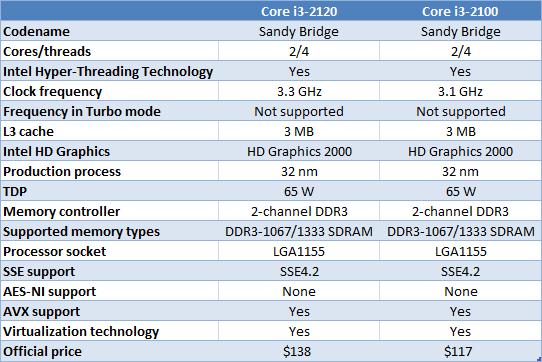
Two cores are coupled with Hyper-Threading technology that presents Core i3 processors as quad-core CPUs to the operating system. The absence of Turbo Boost support is compensated by nominal clock frequency exceeding 3 GHz. In other words, Core i3-2120 and Core i3-2100 do not look that bad after all. Especially, since they also feature a fully-functional Intel HD Graphics 2000 core working at 850-1100 MHz frequency and supporting Quick Sync technology. Lower power consumption is another benefit of having fewer computational cores. The TDP of these processors is set at 65 W instead of 95 W we saw by Core i7 and Core i5.
However, Core i3 CPU series has one more issue. For some reason, these processors do not support AESNI cryptographic instructions, although the newer AVX instructions are there alright. It must be some kind of marketing thing, which is inherited from older Core i3 processors on Clarkdale design.
But compared against the previous generation, the new Core i3 processors allow more flexible DDR3 SDRAM clocking. You can set the memory frequency not only to its default values, but also to much higher ones, including DDR3-1600, DDR3-1866, DDR3-21330, etc. However, the value of this feature is totally diminished by the overclocking-unfriendliness of the new processors.
Testbed Configuration and Methodology
Since our goal was to adequately measure the performance of Core i3 processors based on Sandy Bridge microarchitecture, we found ourselves in a pretty tricky situation. On the one hand, these are relatively inexpensive products, which price is about the same as that of previous-generation dual-core CPUs. On the other hand, the comparison between the new Core i3-2120 and Core i2100 and the older dual-core processors won’t be illustrative. As we very well know from our previous tests, Sandy Bridge microarchitecture is much more effective than the predecessors, therefore inexpensive new processors will definitely be faster.
So, we chose two product groups to compete against our Core i3-2120 and Core i3-2100. The first group included previous-generation products that were selling at comparable prices today. They were Core i3-560 with Clarkdale design, LGA775 Core 2 Duo E7600 from Wolfdale family and a quad-core AMD Phenom II X4 955, which price has rapidly dropped down to $135 right after the Sandy Bridge launch. The second group included Core i5 processors: junior quad-core Core i5-750 and Core i5-2300 models in LGA1156 and LGA1155 form-factor and the fastest Clarkdale CPU – Core i5-680.
The list below shows all hardware and software components participating in this test session:
- Processors:
- AMD Phenom II X4 955 (Deneb, 4 cores, 3.2 GHz, 6 L3);
- Intel Core i5-2300 (Sandy Bridge, 4 cores, 2.8 GHz, 6 MB L3);
- Intel Core i5-750 (Lynnfiled, 4 cores, 2.66 GHz, 8 MB L3);
- Intel Core i5-680 (Clarkdale, 2 cores, 3.6 GHz, 4 MB L3);
- Intel Core i3-2120 (Sandy Bridge, 2 cores, 3.3 GHz, 3 MB L3);
- Intel Core i3-2100 (Sandy Bridge, 2 cores, 3.1 GHz, 3 MB L3);
- Intel Core i3-560 (Clarkdale, 2 cores, 3.33 GHz, 4 MB L3);
- Intel Core 2 Duo E7600 (Wolfdale, 2 cores, 3.06 GHz, 3 MB L2).
- Mainboards:
- ASUS Crosshair IV Formula (Socket AM3, AMD 890FX + SB850, DDR3 SDRAM);
- ASUS P8P67 Deluxe (LGA1155, Intel P67 Express);
- ASUS P5Q3 (LGA775, Intel P45 Express, DDR3 SDRAM);
- Gigabyte P55A-UD6 (LGA1156, Intel P55 Express).
- Memory — 2 x 2 GB DDR3 SDRAM (Kingston KHX1600C8D3K2/4GX):
- DDR3-1067 7-7-7-21 with Core 2 Duo E7600 processor;
- DDR3-1333 9-9-9-27 with Core i3-560, Core i5-680 and Core i5-750 processors;
- DDR3-1600 9-9-9-27 with Phenom II X4 955, Core i5-2300, Core i3-2120 and Core i3-2100 processors.
- Graphics card: ATI Radeon HD 6970.
- Hard drive: Kingston SNVP325-S2/128GB.
- Power supply unit: Tagan TG880-U33II (880 W).
- Operating system: Microsoft Windows 7 SP1 Ultimate x64.
- Drivers:
- Intel Chipset Driver 9.2.0.1025;
- Intel Rapid Storage Technology 10.1.0.1008;
- ATI Catalyst 11.3 Display Driver.
Performance
General Performance
As usual, we use SYSmark 2007 suite to estimate the processor performance in general-purpose tasks. It emulates the usage models in popular office and digital content creation and processing applications. The idea behind this test is fairly simple: it produces a single score characterizing the average computer performance.
Although the results of the new Core i3 processors look extremely optimistic, there is no foul play here. Many applications used in SYSmark 2007 for performance evaluation can split the load well only in two parallel threads. That is why dual-core processors score really high in this test, which is, in fact, very true for the today’s mainstream software market.as a result, new-generation Core i3 processors based on advanced Sandy Bridge microarchitecture turn out faster than even quad-core Core i5-750 and Phenom II X4 955. At the same time, contemporary quad-core Core i5-2300 is 5% faster than Core i3-2120.
As for the results of dual-core processors alone, we can state that new generation Core i3 CPUs get very close to the previous generation dual-core Core i5. And within their price range, Core i3-2120 and Core i3-2100 processors deliver about 10% higher performance than LGA1156 CPUs and more than 30% higher performance compared with LGA775 processors.
We would like to add a detailed results table to our SYSmark 2007 diagrams. All results are sorted according to the application type:
Gaming Performance
As you know, it is the graphics subsystem that determines the performance of the entire platform equipped with pretty high-speed processors in the majority of contemporary games. Therefore, we do our best to make sure that the graphics card is not loaded too heavily during the test session: we select the most CPU-dependent tests and all tests are performed without antialiasing and in far not the highest screen resolutions. In other words, obtained results allow us to analyze not that much the fps rate that can be achieved in systems equipped with contemporary graphics accelerators, but rather how well contemporary processors can cope with gaming workload. Therefore, the results help us determine how the tested CPUs will behave in the nearest future, when new faster graphics card generations will be widely available.
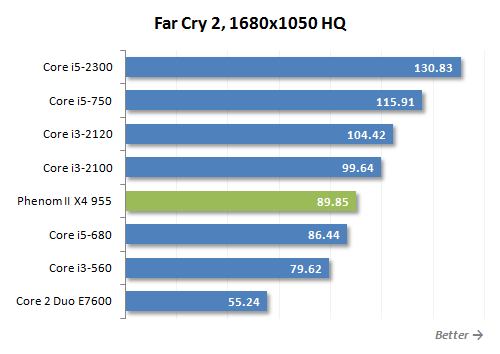
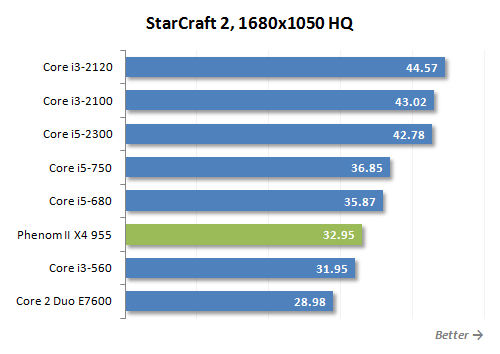
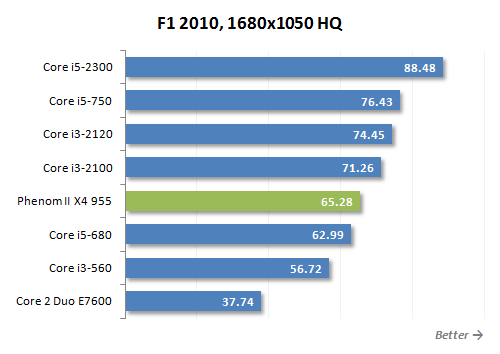
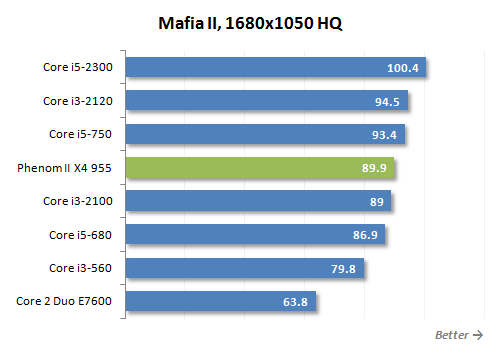
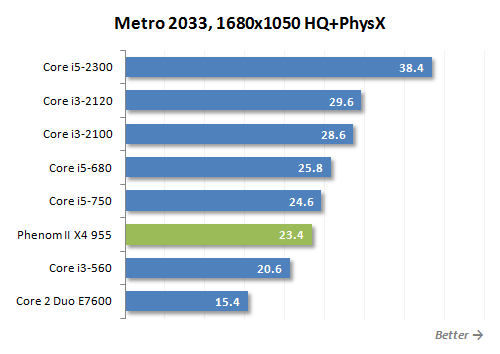
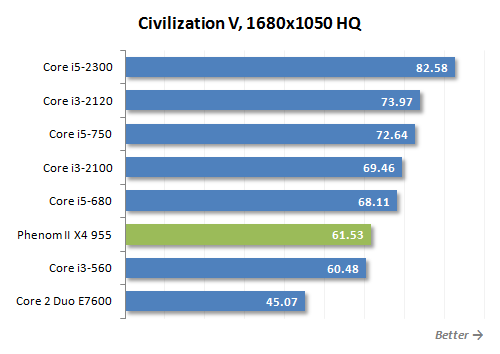
We are already used to the fact that when it comes to gaming performance of the new processors, there is only one conclusion to be drawn: Sandy Bridge are excellent gaming CPUs. There is nothing new to add this time, too. Core i3-2120 and Core i3-2100 run faster than any dual-core CPUs of the same class yielding to quad-core parts only in games that are well optimized for multi-threading.
The fact that Core i3-2100 more than 30% faster (on average) than Core i3-560 once again confirms that the new generation processors are highly advanced. And Sandy Bridge microarchitecture is the one that deserves all the credit. Both CPUs work at close frequencies, have the same number of cores and support Hyper-Threading. Moreover, Core i3-560 even has a slightly larger L3 cache, but despite all that we witness an enormous difference in performance. Of course, Sandy Bridge processors owe some of their success to the faster memory controller. The new Core i3 CPUs have their memory controller in the same semiconductor die as the computational cores. Besides it supports faster DDR3 types. However, this tremendous performance advantage cannot be explained only by the increased memory sub-system speed. There obviously are other reasons for that.
Archiving and Encryption
To test the processors performance during data archiving we resort to WinRAR archiving utility. Using maximum compression rate we archive a folder with multiple files 699 MB in total size.
Archiving speed is closely connected not only to the processors’ computational performance, but also with the practical memory sub-system bandwidth. Therefore, the results demonstrated by new Core i3 processors do not surprise us at all: their advantage over any other dual-core CPUs is quite logical. Higher-end Core i5-750 CPU manages to use its four fully functional cores to compete successfully against the newcomers, so it would be too early to claim that dual-core Sandy Bridge processors have totally outdone the previous-generation quad-cores.
The processor performance during encryption is measured with an integrated benchmark from a popular cryptographic utility called TrueCrypt. I have to say that it can not only effectively utilize any number of processor cores, but also supports special AES instructions.
The encryption tests ranks all processors in accordance with their positioning, and the Core i3 series always appears below Core i5 on the diagrams. The reason for that is fairly simple: Core i3 CPUs do not support AES instructions used in TrueCrypt that is why they lose to dual-core Core i5 from the Westmere generation. There is no real serious reason behind the missing AES instructions. It is a purely marking move that Intel uses to differentiate between CPU families, just like their use the disabled Turbo Boost.
Image Editing
We measured the performance in Adobe Photoshop using our own benchmark made from Retouch Artists Photoshop Speed Test that has been creatively modified. It includes typical editing of four 10-megapixel images from a digital photo camera.
The new Core i3-2120 and Core i3-2100 show their strengths in Photoshop. And although they are pretty far behind the quad-core Sandy Bridge processors, they still defeat older CPU models, including the quad-core ones with flying colors. For example, Core i5-750 is about 5% slower than the junior Core i3-2100, while Phenom II X4 955 from AMD is 28% behind the dual-core Intel CPU.
We have also performed some tests in Adobe Photoshop Lightroom 3 program. The test scenario includes post-processing and export into JPEG format of a hundred 12-megapixel images in RAW format.
Things look a little different in Lightroom, because this application uses the advantages of multi-core processors more efficiently. But after that, things become totally typical. There simply aren’t any dual-core processors that could compare in performance to Core i3-2120 and Core i3-2100. But the most impressive gap is between the newcomers and the slowly retiring LGA775 CPUs, even though it has been only three years since Wolfdale core made its market debut.
Audio Processing
We use Apple iTunes utility to test audio transcoding speed. It transcodes the contents of a CD disk into AAC format. Note that the typical peculiarity of this utility is its ability to utilize only a pair of processor cores.
Things look a little different in Lightroom, because this application uses the advantages of multi-core processors more efficiently. But after that, things become totally typical. There simply aren’t any dual-core processors that could compare in performance to Core i3-2120 and Core i3-2100. But the most impressive gap is between the newcomers and the slowly retiring LGA775 CPUs, even though it has been only three years since Wolfdale core made its market debut.
Audio Processing
We use Apple iTunes utility to test audio transcoding speed. It transcodes the contents of a CD disk into AAC format. Note that the typical peculiarity of this utility is its ability to utilize only a pair of processor cores.
Dual-core Sandy Bridge processors perform almost as good as the fastest Clarkdale solutions. However, the difference in their clock frequency is about 400-500 MHz, so we can only admire once again how successfully Intel developers managed to improve the performance of their new cores. Namely, Core i3-2120 outperforms by about 15% the Core i3-560 CPU working at the same clock frequency. And that is purely due to microarchitectural advantages, because audio transcoding is one of those tasks, where memory and cache memory bandwidth do not matter.
The test in Cakewalk Sonar X1 measured the time it took to mix a short test track.
Sonar is an application that utilizes all CPU cores, no matter how many there are. But despite this fact, Core i3-2120 and Core i3-2100 are still very hard to outrun. Only Core i5-2300 based on the same Sandy Bridge microarchitecture proves up to the task.
Video Transcoding
In order to measure how fast our testing participants can transcode a video into H.264 format we used x264 HD benchmark. It works with an original MPEG-2 video recorded in 720p resolution with 4 Mbps bitrate. I have to say that the results of this test are of great practical value, because the x264 codec is also part of numerous popular transcoding utilities, such as HandBrake, MeGUI, VirtualDub, etc.
Video transcoding using x264 codec is one of those few tasks where the number of processor cores matters a lot. That is why here new dual-core Core i3-2120 and Core i3-2100 can’t compete against Core i5-750 or against Phenom II X4 955. Of course, they are better than any other dual-core processors, but if you need to process video fast, then your best bet would be on quad- or six-core CPUs.
The performance in Adobe Premiere Pro is determined by the time it takes to render a Blu-ray project with a HDV 1080p25 video into H.264 format and apply different special effects to it.
We see similar picture in Adobe Premiere Pro. New generation Core i3 processors run as fast as Core i5 on Clarkdale, but no faster than that. Of course, you can pin your hopes on the integrated Quick Sync technology, which should theoretically speed up video content transcoding quite substantially, but do not forget that it will only work if the following two conditions are met. First, the application should support this technology, and second, Quick Sync will only work if the integrated graphics is used.
Final Rendering
We use special Cinebench test to measure the final rendering speed in Maxon Cinema 4D.
Rendering, just like video transcoding, is one of those tasks that can use any number of cores quite effectively. In the meanwhile, Sandy Bridge microarchitecture is not efficient enough for one new core to replace two old ones, because Core i3-2120 is only 15% faster than Core i3-560. So, quad-core CPUs will anyway be faster than Core i3-2120 or Core i3-2100. However, Sandy Bridge is totally undefeated in the dual-core group. Only Core i5-680 tries to squeeze in-between Core i3-2120 and Core i3-2100, but its $300 price tag doesn’t allow us to seriously consider this attempt.
Rendering speed in Autodesk 3ds max 2011 with both, Scanline as well as Mental Ray, was measured using SPECapc test.
This is another rendering application, but the results are again almost the same. New Core i3 processors today perform as fast as last year’s top dual-core Core i5 CPUs on Clarkdale core would.
Power Consumption
Sandy Bridge processors manufactured with progressive 32 nm process have already set a new energy-efficiency standard. However, our today’s heroes – Core i3-2120 and Core i3-2100 – are a little different from those second-generation Core processors, which we have discussed before. Dual-core processors use a slightly different reduced semiconductor die with almost half the transistors. So, it seems quite logical to expect these processors to show even lower power consumption readings. Especially, since their TDP is set at 65 W, while quad-core Sandy Bridge processors have their TDP at 95 W.
Of course, we performed a few practical tests. The graphs below show the full power draw of the computer (without the monitor) measured after the power supply. It is the total of the power consumption of all the system components. The PSU’s efficiency is not taken into account. The CPUs are loaded by running the 64-bit LinX 0.6.4 utility. We enabled all the power-saving technologies for a correct measurement of the computer’s power draw in idle mode: C1E, AMD Cool’n’Quiet and Enhanced Intel SpeedStep.
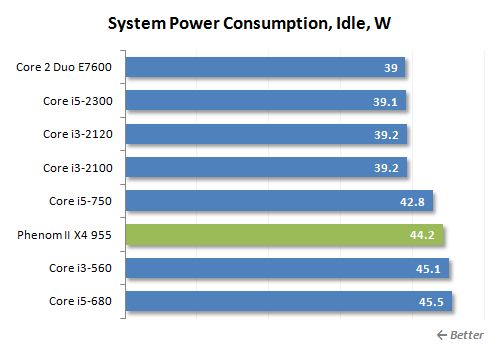
Strange as it might seem, power consumption of the dual-core Sandy Bridge CPUs is at the same level as the power consumption of their quad-core counterparts. Obviously, the power-saving technologies in the new processors have become so advanced that idling computational cores barely use any power at all. At the same time, the power consumption of the entire LGA1155 platform in idle mode is very close to that of LGA775 systems, which remained among the energy-efficiency leaders in idle mode for a long time due to their simple design and structure.
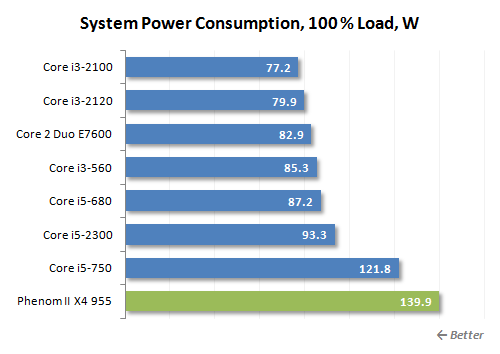
However, under maximum load all our expectations come true. Core i3-2120 and Core i3-2100 turns out the most energy-efficient processors in our today’s test session. All this makes dual-core Sandy Bridge CPUs a extremely appealing choice for an HTPC system, because when their integrated graphics core is disabled they consume anywhere between 5 and 35 W depending on the workload. However, keep in mind that Intel also offers even more energy-efficient processors (although they are also more expensive) that belong to the T series.
Conclusion
We can’t say that the results of our today’s Core i3-2120 and Core i3-2100 turned out unexpected. Since these processors are based on the new Sandy Bridge microarchitecture, they boast all the advantages, which we have already praised during our earlier discussion of the quad-core processors from this family. In other words, if we compare dual-core LGA1155 with the similar predecessors for the LGA1156 platform, the former will stand out due to increased performance as well as decreased power consumption.
And the examples are right in front of us: Core i3-2120 is about 24% faster on average than Core i3-560. And both these processors have the same official MSRP and very similar clock frequency, so that the only thing different is the microarchitecture. All this allows us to successfully compare new Core i3-2120 and Core i3-2100 with the higher-end old dual-core LGA1156 processors from the Core i5-600 series.
However, even though the relative performance per core has significantly increased, dual-core Sandy bridge processors still aren’t strong enough to challenge the old quad-cores. Core i3-2120 and Core i3-2100 yield to both: LGA1156 as well as Socket AM3 quad-core processors in those applications that can efficiently split the workload into parallel threads. Therefore, older platforms with quad-core CPUs remain a better choice for such tasks a non-linear video editing and transcoding or final rendering. However, Core i3-2120 and Core i3-2100 will definitely be preferable in general-purpose applications, including many contemporary games, especially keeping in mind their lower power consumption and the growing popularity of the LGA1155 platform in general.
Overall, Core i3-2120 and Core i3-2100 appear to be a good and inexpensive addition to the Core i7 and Core i5 LGA1155 series. If you are ready to settle for a dual-core CPU with Hyper-Threading support instead of a fully-functional quad-core, these Sandy Bridge products will be the best choice for almost any situation. The only weakness of the new Core i3-2120 and Core i3-2100 is complete unfitness for overclocking, which makes them very unappealing for computer enthusiasts.
However, do not forget that these processors boast a pretty decent integrated graphics core – Intel HD Graphics 2000, which means that even though some enthusiasts may not want to have these processors in their everyday systems, they will still consider them eagerly for compact multimedia PCs.